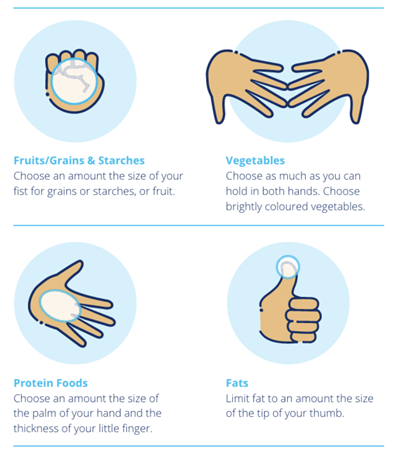Eating away from home has become a part of many people’s lifestyle. Making healthy choices when you are out and about helps maintain target blood sugar levels. For more information and tips for eating away from home click here.
Getting the right balance and portion size
Canada’s Food Guide contains three major food groups:
- Vegetables and fruits
- Whole grains
- Protein foods
Including foods from each category in your day ensures that your body gets all the nutrients it needs. Using The Plate Method can help you to manage portions and get the right balance when you plan your meals. In addition to the Plate Method, the Handy Portion Guide also helps to keep your portion sizes in check.
Check your portion sizes
Foods eaten away from home are often served in portions that are very large. To keep your blood sugar levels stable while eating away from home you may need to adjust the portion size, your insulin dose (if you use insulin), or your physical activity. If the serving size is larger or smaller than your usual portion or if the meal is delayed, your blood glucose level will be affected. In a restaurant, you can ask for your leftovers to be packed, share your entrée with someone else, or request for half portions.
Handy portion guide
Your hands can be very useful in estimating appropriate portions. When planning a meal, use the following portion sizes as a guide:

Packing meals to take with you
When possible, packing meals to take with you when you go out is a great option. Bring healthy food from home with you, such as a lunch container filled with brown rice (about the size of your fist), a palm-size portion of lean meat, chicken or fish and plenty of raw or cooked vegetables; or sandwiches on whole grain breads, nuts, fruits, and vegetables.
Watching your carbohydrates while away from home
Foods that contain carbohydrates raise your blood sugar. To manage diabetes, you need to know which foods contain carbohydrates and how much carbohydrate is in your meal or snack. This is also important to watch when you are away from home. If you are on insulin, speak to your healthcare team about planning your meals and insulin adjustments.
General guidelines on carbohydrate amount
The amount of carbohydrate you should eat is based on your individual needs; talk to the dietitian on your health care team to see what amount is right for you. Below is a general guideline:
|
Carbohydrate Amount |
Women |
Men |
|---|---|---|
|
In a meal |
45 to 60 grams |
60 to 75 grams |
|
In a snack |
15 to 30 grams |
15 to 30 grams |
What should my blood glucose be before and after meals?
Know your target and be sure to check your blood sugar when you are eating away from home. This way you will know whether the amount of carbohydrate you consume is too little, just enough, or too much. This will help you to plan for future meals. Start by checking your blood glucose before you eat and again 2 hours after the start of your meal.
| Before meals | 4 to 7 mmol/L |
|---|---|
| 2 hours after the start of the meal | 5 to 10 mmol/L |
If your blood glucose is too high after meals, ask yourself:
- Did I include some protein and fat? (including protein and fats helps keep blood glucose from going too high)
- Did I eat too many carbohydrates? (carbohydrates are foods that raise your blood glucose the most)
- Did I get enough exercise? (exercise can help keep your blood glucose in target)
- Should I talk to my healthcare team about changing my medications?
Try to eat on time
Your meals should be spaced 4 to 6 hours apart. If your meal will be earlier or later than usual, you may need to adjust your insulin (if you use insulin) or change the timing of a snack. This will help avoid high or low blood sugars. If you know you will be eating away from home, try not to skip meals or snacks if they are part of your meal plan. Skipping meals may cause you to overeat when you get to the restaurant or event so be sure to eat your usual meals and snacks before you head out.
Related Content

Diabetes-friendly recipes
Try our delicious recipes for every dietary need and any meal of the day—including snacks.
Browse recipes About Diabetes-friendly recipes

Tools & resources
We've got dozens of tools and resources to help you understand and manage diabetes.
Tools & resources About Tools & resources